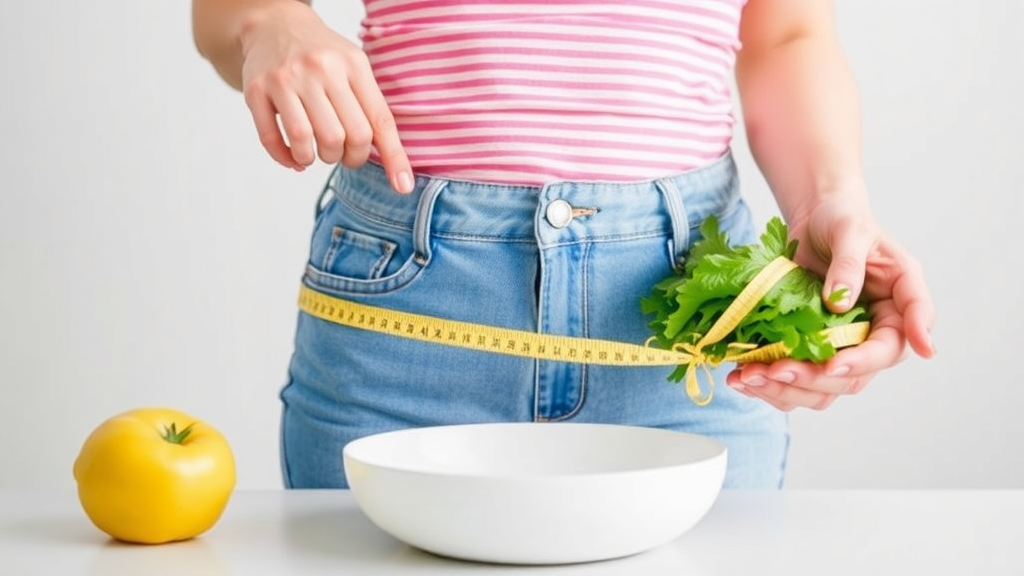Does Eating Less Always Lead to Weight Loss? Understanding Calorie Deficits
When it comes to weight loss, many people assume that simply eating less will lead to a slimmer waistline. However, it’s essential to understand the science of calorie deficits to grasp why this may not always be the case. A calorie deficit occurs when you consume fewer calories than your body burns. This concept is fundamental to weight loss but involves more than just eating less food.
First, it’s crucial to know that not all calories are equal. The source of your calories plays a significant role in how your body processes them. For example, 100 calories from a candy bar will affect your body differently than 100 calories from vegetables. Nutrient-dense foods provide essential vitamins and minerals while helping you feel fuller longer. Foods high in sugar and unhealthy fats may lead to overeating even if they are low in calories.
To effectively manage your weight, consider the following:
- Balance is key: Focus on a diet rich in fruits, vegetables, lean proteins, and whole grains.
- Quality over quantity: Choose whole foods that are minimally processed.
- Mindful eating: Pay attention to hunger cues and eat slowly to recognize fullness.
Another aspect to consider is individual metabolism. Each person has a unique metabolic rate, which determines how many calories you burn at rest. Factors influencing your metabolism include:
- Age: Metabolism generally slows down as we age.
- Muscle mass: More muscle increases your resting metabolic rate.
- Hormonal balance: Hormones can impact how your body processes food and stores fat.
For effective weight management, understanding your personal calorie needs is vital. You can use various online tools or consult a nutritionist to assess your daily caloric requirements based on your age, gender, weight, height, and activity level.
When you create a calorie deficit, it’s not only about eating less but also about eating smart. Here are some strategies to help you maintain a healthy caloric intake:
- Track your intake. Use apps like MyFitnessPal to monitor what you eat.
- Plan meals. Preparing meals in advance can help you avoid unhealthy choices.
- Stay hydrated. Sometimes thirst is mistaken for hunger.
However, it’s important to not starve yourself or cut calories too drastically. Severe caloric restriction can lead to muscle loss, nutritional deficiencies, and a slowdown in your metabolism. Instead of extreme dieting, aim for a moderate deficit of about 500 to 1000 calories a day. This typically leads to a healthy weight loss of 1 to 2 pounds per week.
Another factor to keep in mind is that your body will adapt to weight loss. Initially, you may lose weight quickly, but as you lose pounds, your metabolism may slow down, causing weight loss to plateau. This process highlights the importance of adjusting your calorie intake and exercise regimen periodically to continue making progress.
Here’s a simple table to illustrate a calorie deficit approach:
| Activity Level | Daily Caloric Needs | Suggested Caloric Intake for Weight Loss (500 Calorie Deficit) |
|---|---|---|
| Sedentary | 2000 | 1500 |
| Moderately Active | 2200 | 1700 |
| Active | 2400 | 1900 |
While it may seem intuitive that eating less leads to weight loss, a deeper understanding of calorie deficits reveals that the quality of food, individual metabolism, and overall lifestyle play significant roles. To learn more about creating a healthy eating plan, consider checking resources like Nutrition.gov or Harvard T.H. Chan School of Public Health.
Ultimately, aim to develop a balanced approach that combines healthy eating with physical activity. This method not only helps you lose weight but also promotes overall well-being, allowing you to maintain your results in the long term.
The Science Behind Caloric Balance: How It Affects Your Body
The concept of caloric balance is fundamental to understanding how our bodies function, especially regarding weight management. Essentially, caloric balance refers to the relationship between the number of calories you consume and the number of calories your body uses. This balance plays a critical role in determining whether you gain, lose, or maintain weight.
Understanding Caloric Intake and Expenditure
Your body needs energy to function. This energy comes from the food you eat, which is measured in calories. Caloric intake can be influenced by various factors, such as:
- Type of food consumed
- Portion sizes
- Meal frequency
- Physical activity levels
On the flip side, caloric expenditure is the number of calories your body burns through various activities, which can be divided into three main components:
- Basal Metabolic Rate (BMR): The energy used while at rest, maintaining basic bodily functions like breathing and circulation.
- Physical Activity: The calories burned through exercise and daily movements.
- Thermic Effect of Food (TEF): The energy required to digest and metabolize food.
What is a Caloric Deficit?
A caloric deficit occurs when you consume fewer calories than your body expends. This deficit is essential for weight loss. However, achieving a caloric deficit can be complex and requires a balanced approach. Here’s how it works:
- If you maintain a consistent caloric deficit—through diet and increased physical activity—you will lose weight over time.
- Even small deficits can result in significant weight loss over weeks or months.
Factors Influencing Caloric Balance
Several factors can impact your caloric balance, including:
- Age: Caloric needs often decrease with age due to lower BMR.
- Muscle Mass: More muscle mass leads to higher calorie expenditure at rest.
- Medical Conditions: Certain health issues may influence metabolism and appetite.
The Role of Macronutrients
The types of foods you eat can affect your caloric balance as well. Foods high in protein can help you feel full longer, which can be beneficial when trying to maintain a caloric deficit. Here’s a breakdown of macronutrient roles in caloric balance:
| Macronutrient | Calories per Gram | Function |
|---|---|---|
| Carbohydrates | 4 | Primary energy source |
| Proteins | 4 | Supports muscle building and repair |
| Fats | 9 | Essential for hormone production and energy storage |
The Importance of a Sustainable Approach
While it’s true that eating less can lead to weight loss, it’s crucial to prioritize healthy eating habits and sustainability. Extreme caloric restriction can lead to nutrient deficiencies and negative health effects. Instead, focus on a moderate caloric deficit and a balanced diet that includes:
- Fruits and vegetables
- Whole grains
- Lean proteins
- Healthy fats
Additionally, incorporating physical activity into your routine can further improve your caloric balance.
Monitoring Your Progress
Tracking your caloric intake and expenditure can help you understand your body’s needs better. Use apps or trackers to monitor your meals and activities. Adjust your diet and exercise routines based on your goals, whether it’s losing, maintaining, or gaining weight.
The science behind caloric balance reinforces that you need to create a strategy that aligns with your lifestyle and goals. Remember, it’s not just about eating less; it’s about making healthier choices that contribute to an overall balanced diet and better well-being. For more information, you can refer to resources like Choose My Plate or the Nutrition.gov.
Quality vs. Quantity: The Role of Nutrient-Dense Foods in Weight Management
The relationship between food quality and quantity plays a crucial role in effective weight management. Many people focus solely on calorie counting, often overlooking the nutritional value of the foods they consume. A calorie is not merely a calorie; the source of that calorie can significantly impact your health, energy levels, and ability to maintain a healthy weight.
Nutrient-dense foods pack a lot of nutrition into a relatively low number of calories. These foods are high in vitamins, minerals, fiber, and other essential nutrients while being lower in added sugars and unhealthy fats. nutrient-dense foods into your diet can lead to better satiety, improved health, and easier weight management. Let’s take a closer look at why focusing on quality can be more beneficial than simply tracking quantity.
Benefits of Nutrient-Dense Foods
Choosing nutrient-dense foods has numerous advantages when it comes to weight management:
- Better Satiety: Foods rich in fiber and protein keep you feeling full longer. This helps to prevent unnecessary snacking and overeating.
- Reduced Caloric Intake: Since nutrient-dense foods tend to be lower in calories, you can eat larger portions without exceeding your caloric needs.
- Improved Metabolism: Foods high in nutrients can enhance metabolic processes, maintaining healthy energy levels while promoting fat loss.
- Increased Nutritional Intake: By filling your plate with a variety of nutrient-dense options, you ensure your body gets the vitamins and minerals it needs to function optimally.
Examples of Nutrient-Dense Foods
When creating a healthy meal plan, focus on including a variety of nutrient-dense foods. Here are some excellent choices:
| Food Group | Nutrient-Dense Foods |
|---|---|
| Fruits & Vegetables | Spinach, kale, broccoli, blueberries, apples, and carrots |
| Whole Grains | Quinoa, brown rice, oats, and whole grain bread |
| Proteins | Lean turkey, chicken breast, beans, lentils, and Greek yogurt |
| Healthy Fats | Avocados, nuts, seeds, and olive oil |
Caloric Quality vs. Quantity
The notion that eating less will always lead to weight loss can be misleading. Consuming many low-quality, calorie-dense foods can lead to hunger and cravings, making it difficult to stick to a calorie deficit. On the other hand, you can eat more while still losing weight by focusing on nutrient-dense, low-calorie foods. For instance, a large salad filled with colorful vegetables can be far more satisfying and nutritious than a small serving of chips.
Understanding Portion Sizes
While nutrient density is vital, being mindful of portion sizes is also essential. Eating large quantities, even of healthy foods, can lead to excess calorie consumption. Here are some tips to manage portions:
- Use Smaller Plates: This simple change can help control portions while still allowing you to enjoy your meals.
- Practice Mindful Eating: Eat slowly and pay attention to hunger cues. This helps prevent overeating.
- Plan Meals Ahead: Preparing meals in advance can help streamline portion sizes and ensure you make nutritious choices.
Finding a Balance
Achieving a healthy weight is about balance. Rather than fixating on strict calorie limits, aim for a well-rounded diet rich in nutrients. This approach not only supports weight management but also contributes to overall well-being. For more detailed guidance on nutrition, you can explore resources from the Academy of Nutrition and Dietetics or Healthline.
Ultimately, prioritizing nutrient-dense foods over empty calories might just be the key to unlocking sustainable weight management. By elevating the quality of your meals, you stand a better chance of reaching and maintaining your health goals while still enjoying your food.
Common Myths about Dieting and Weight Loss: Debunking Misconceptions
When you hear talk about dieting and weight loss, numerous myths surface that can mislead even the most dedicated individuals. These myths can discourage people from sticking to a diet plan or adopting a healthy lifestyle. Let’s delve into some prevalent misconceptions regarding dieting and weight loss, debunking them along the way.
Myth 1: Carbs are the Enemy
Many dieters believe that cutting out carbohydrates entirely is the key to weight loss. While it is true that not all carbs are created equal, completely avoiding them can be harmful. Carbohydrates are a primary energy source for your body. Instead of banishing carbs, focus on choosing whole grains, fruits, and vegetables, which provide essential nutrients. According to ChooseMyPlate.gov, a balanced diet includes a moderate amount of healthy carbs.
Myth 2: Skipping Meals Helps You Lose Weight
Many people think that skipping meals can lead to faster weight loss. However, this approach can backfire. When you skip meals, your body can go into starvation mode, slowing down your metabolism. This can lead to overeating later in the day. Instead of skipping meals, aim for smaller, nutritious meals throughout the day. The Academy of Nutrition and Dietetics suggests that consistent meal timing is essential for a healthy metabolism.
Myth 3: All Fats are Bad
Another common myth is that all dietary fats contribute to weight gain. In reality, fats are an essential part of a healthy diet. Healthy fats, such as those found in avocados, nuts, and olive oil, can actually support weight loss. They help keep you satisfied longer and can improve heart health. Replacing unhealthy fats with healthy ones is the best approach. According to a report from Harvard Health, incorporating healthy fats can reduce hunger and cravings.
Myth 4: Eating Late at Night Causes Weight Gain
Eating late at night is often demonized, but it’s not about the timing as much as it is about what and how much you’re eating. If you’re consuming high-calorie snacks mindlessly while watching TV, that’s likely contributing to weight gain, not the clock. The quality of your meals and portion control is what matters most. To maintain healthy eating habits, focus on choosing nutritious snacks rather than cutting off eating after a certain time.
Myth 5: Drinking Water Alone Will Help You Lose Weight
While staying hydrated is critical for overall health, drinking extra water won’t magically melt away pounds. However, drinking water before meals might help you consume fewer calories. This is due to the sensation of fullness you feel from hydration. Remember that weight loss results from a caloric deficit achieved through a combination of healthy eating and physical activity. The CDC indicates that this balance is key to effective weight management.
Myth 6: Supplements Can Replace a Healthy Diet
Many people are tempted to rely on weight loss supplements as a quick fix. However, these products are not a substitute for a balanced, nutritious diet. Relying solely on supplements can lead to deficiencies and may not promote sustainable weight loss. Focus on whole foods with vitamins and nutrients instead. Natural foods are not only healthier but also tend to have fewer calories than processed foods.
Myth 7: Weight Loss Is Linear
People often expect weight loss to occur steadily. However, fluctuations in weight are perfectly normal and can happen for different reasons, including water retention, hormonal changes, and muscle gain. Understanding that weight loss is not a linear path can help you avoid getting discouraged by temporary setbacks. Set realistic and progressive goals instead.
| Myth | Truth |
|---|---|
| All carbs are bad | Healthy carbs are vital for energy. |
| Skipping meals helps in weight loss | Consistent, balanced meals support metabolism. |
| All fats make you gain weight | Healthy fats can aid in satiety. |
| Eating late causes weight gain | Mindful eating is what’s important. |
| Water alone can help in weight loss | It supports hydration, not direct weight loss. |
| Supplements can replace a diet | Whole foods provide necessary nutrition. |
| Weight loss is always consistent | Fluctuations are normal and expected. |
When navigating the world of dieting and weight loss, it’s crucial to separate fact from fiction. By debunking these common myths, you’ll have a clearer understanding of how to approach your weight loss journey in a healthy, sustainable way. Stay informed, and remember to prioritize your overall wellness.
Psychological Factors in Eating: How Emotions Influence Food Choices
Understanding the relationship between emotions and eating can help you make better food choices. Many people experience strong emotional connections to their meals, and these feelings can cause them to eat in ways that may not align with their health goals.
When you feel stressed, anxious, happy, or even bored, you might reach for food without realizing it. This behavior often leads to unhealthy eating patterns. Let’s explore some of the psychological factors that influence your food choices:
Emotional Eating
Emotional eating occurs when individuals use food to cope with their feelings. This habit can lead to excessive calorie intake and result in weight gain. Here are some reasons why emotional eating happens:
- Stress Relief: Many turn to comfort foods during stressful times, believing these foods can provide a sense of relief or happiness.
- Boredom: Eating can be a distraction when you feel bored. It provides something to do when nothing seems interesting.
- Celebration: Food often plays a significant role in celebrations. You may find yourself eating more during events or parties.
- Sadness: When you’re feeling down, you might indulge in your favorite foods as a way to cope.
Cravings and Emotional Triggers
Understanding your cravings can help you manage them. Emotional triggers often lead to specific food cravings. Here’s how emotions can create cravings:
- Happy Moments: You might crave sweets or snacks when you feel joyful, associating these foods with good times.
- Loneliness: When feeling lonely, you may often seek out indulgent or high-calorie foods for comfort.
- Anxiety and Stress: Stressful emotions may trigger cravings for high-sugar and carbohydrate-rich foods as they can promote a sense of calm.
Mindful Eating Techniques
To combat emotional eating, practicing mindful eating can be beneficial. Mindfulness can help you gain a better understanding of your eating habits and the emotional triggers behind them. Here are some strategies:
- Slow Down: Take your time to eat. This allows you to enjoy your food and better recognize when you feel full.
- Pace Yourself: Create a distraction-free environment where you can focus solely on your meal.
- Identify Emotions: Before reaching for food, pause to identify what you are feeling. This can help you choose healthier responses.
The Role of Environment
Your surroundings also influence your food choices. An environment filled with unhealthy food options can lead to poor choices. Consider the following:
- Accessibility: If sodas and sweets are readily available, you’re more likely to consume them. Stock healthy snacks like fruits and vegetables instead.
- Social Influences: Friends and family can greatly affect your eating behaviors. Being around health-conscious individuals can encourage you to make healthier choices.
Seeking Professional Help
If you find it challenging to break free from emotional eating patterns, consider seeking help from professionals. Registered dietitians and therapists can provide you with the tools and support you need. You can learn to address the emotional aspects of your eating behavior steadily.
By recognizing the psychological factors that influence your food choices, you can take proactive steps to establish a healthier relationship with food. Understanding your emotions and their connection to your eating habits is a vital part in achieving your well-being goals.
For more information on the psychology of eating and emotional triggers, check out reputable sources like Eat Right and Psychology Today.
Ultimately, being aware of how emotions influence your food choices can empower you to make decisions that favor your health and happiness over time. With a focus on mindfulness and emotional clarity, you can cultivate a balanced and enjoyable relationship with food.
The Importance of Physical Activity: Beyond Just Cutting Calories
When people think about losing weight, the first thing that often comes to mind is eating less. While creating a calorie deficit is crucial for weight loss, incorporating physical activity is equally important for overall health and effective weight management. It’s vital to understand how exercise complements dietary changes and enhances well-being beyond just cutting calories.
Physical activity plays a pivotal role in weight loss for several reasons:
- Increases Caloric Burn: Engaging in regular physical activity helps burn more calories throughout the day. The more active you are, the higher your energy expenditure, which can aid in achieving a calorie deficit.
- Preserves Muscle Mass: When you eat less, you risk losing muscle as well as fat. Exercise, especially resistance training, can help in maintaining muscle mass during weight loss. This is crucial because muscle burns more calories at rest than fat does.
- Boosts Metabolism: Regular physical activity can rev up your metabolism. High-Intensity Interval Training (HIIT) and strength training can lead to an increased resting metabolic rate, helping you burn more calories even when you’re not exercising.
- Improves Mood and Motivation: Physical activity releases endorphins, which are natural mood lifters. When you feel good, you’re more likely to stick to your weight loss plan. Being active can reduce feelings of stress, anxiety, and depression, which may otherwise lead to emotional eating.
- Enhances Overall Health: Exercise contributes to cardiovascular health, improves bone density, aids digestion, and boosts the immune system. These health benefits are crucial, especially when you are on a weight loss journey.
Many different types of physical activity can aid in weight loss, including:
- Aerobic Activities: These include walking, running, cycling, and swimming. Aim for at least 150 minutes of moderate-intensity or 75 minutes of high-intensity aerobic exercises each week.
- Strength Training: Incorporate weight lifting or bodyweight exercises at least twice a week. This can help to build and preserve muscle.
- Flexibility and Balance: Activities like yoga or Pilates can improve flexibility and balance and enhance your overall fitness routine.
To effectively combine calorie restriction with physical activity, it’s helpful to understand your personal energy balance. You can calculate your Total Daily Energy Expenditure (TDEE) using an online calculator, which factors in your basal metabolic rate and your activity level. Knowing your TDEE allows you to set realistic calorie goals and exercise plans tailored for you. For more guidance, you can visit Calculator.net.
Here’s a simple breakdown of how to create a weight loss plan that includes both diet and exercise:
| Step | Description |
|---|---|
| 1 | Calculate your TDEE to understand how many calories you should consume to lose weight. |
| 2 | Create a calorie deficit either by eating fewer calories or increasing physical activity, or a combination of both. |
| 3 | Incorporate a mix of aerobic exercise and strength training into your weekly routine. |
| 4 | Monitor your progress regularly and make adjustments as necessary. |
Remember, every individual’s weight loss journey is unique. What works for one person may not work for another. It’s essential to find activities that you enjoy, as this will increase the likelihood of sticking to your exercise routine. You can explore different options by checking out fitness classes online or joining local community events.
In addition to the physical benefits, exercising enhances your mental resilience, self-discipline, and overall sense of achievement. When combined with a balanced diet, you not only shed pounds but also create a healthier lifestyle. If you want to delve deeper into the science behind exercise and weight loss, explore resources available at NCBI.
While eating less can help you lose weight, physical activity is an essential piece of the puzzle for sustainable weight loss and holistic health. Elevate your fitness game, and you’ll likely find it becomes easier to manage your weight effectively.
Sustainable Weight Loss: Building Healthy Habits for the Long Term
Embracing healthy habits is key to achieving sustainable weight loss. It often requires a thoughtful approach focused on lifestyle changes rather than quick fixes. Building these habits can lead not only to shedding pounds but also to a healthier, more fulfilling life.
To effectively lose weight and maintain that loss over time, it’s important to understand that health changes should be gradual and manageable. Here’s a guide to help you develop these long-term habits.
Understand Your Caloric Needs
Every individual has unique caloric needs based on several factors, including age, gender, activity level, and overall health. To promote sustainable weight loss, begin by assessing your caloric intake. Here’s how to do it:
- Calculate your Basal Metabolic Rate (BMR): This number indicates how many calories your body needs at rest.
- Factor in your activity level: Use a Total Daily Energy Expenditure (TDEE) calculator to find out how many calories you burn daily.
- Establish a calorie deficit: Aiming for a deficit of about 500 calories per day can lead to approximately one pound of weight loss per week.
Focus on Nutritional Quality
While cutting calories can lead to weight loss, the quality of those calories plays a crucial role in long-term success. Opt for whole, nutrient-dense foods that nourish your body. Here are some important food groups to include in your diet:
- Fruits and vegetables: Aim for a variety of colors to maximize nutrient intake.
- Whole grains: Choose ingredients like brown rice, quinoa, and whole-grain bread.
- Lean proteins: Incorporate chicken, fish, tofu, and legumes into your meals.
- Healthy fats: Avocados, nuts, seeds, and olive oil can be beneficial.
By making these adjustments to your diet, you will nourish your body while still keeping your calorie intake in check.
Incorporate Regular Exercise
Physical activity is vital when it comes to weight loss and maintaining that weight. regular exercise can help boost your metabolism and burn additional calories. Consider these options:
- Aerobic exercises: Activities like walking, running, swimming, or cycling are effective for burning calories.
- Strength training: Building muscle through weightlifting or bodyweight exercises helps increase your resting metabolic rate.
- Flexibility and balance: yoga or pilates can improve overall fitness and wellbeing.
Try to aim for at least 150 minutes of moderate-intensity aerobic exercise each week, along with two days of strength training.
Practice Mindful Eating
Mindless eating can sabotage your weight loss efforts. By practicing mindful eating, you can develop a healthier relationship with food. Here’s how:
- Pay attention to hunger cues: Learn the difference between hunger and emotional eating.
- Eat slowly: Enjoy each bite, allowing yourself to savor the flavor and texture of the food.
- Limit distractions: Avoid eating in front of the TV or while using your phone to help focus on your meal.
Build a Support System
Having a supportive community can greatly improve your chances of success. This can be friends, family, or a weight loss support group. Consider these steps:
- Share your goals: Let others know what you’re working towards, creating accountability.
- Join local classes or online programs: Many organizations offer support and guidance for weight loss.
- Celebrate milestones together: Recognize achievements, big or small, to stay motivated.
Long-Term Perspective
Remember, sustainable weight loss is a journey, not a destination. Set realistic goals, and understand that slip-ups may happen. Acknowledge your progress, and don’t hesitate to seek professional guidance if needed. For more information on building sustainable habits, visit ChooseMyPlate.gov.
Learn more about maintaining a healthy weight from the National Heart, Lung, and Blood Institute for expert advice on nutrition and activity.
By integrating these habits into your daily routine, you set yourself on a path to healthier living and sustainable weight loss that lasts. Patience and persistence will lead to not just temporary changes but a lifestyle transformation.
Key Takeaway:
When considering whether eating less always leads to weight loss, it’s critical to understand the nuances of calorie deficits and how they impact your body. A calorie deficit occurs when you consume fewer calories than your body burns. This balance is fundamental in weight management, but it’s not the only factor at play. Simply cutting calories may not guarantee weight loss, as the quality of the food consumed also matters significantly.
Research shows that nutrient-dense foods, which provide more vitamins and minerals per calorie, are essential for effective weight management. When you prioritize these foods, you not only nourish your body but also tend to feel satisfied longer, which can help curb overeating. In contrast, focusing solely on reducing calorie intake may lead you to neglect these nutritional aspects, making it harder to sustain weight loss over time.
Moreover, many myths surround dieting and weight loss, such as the idea that cutting carbs is the foolproof way to shed pounds. Debunking these misconceptions is crucial for making informed choices about your eating habits. Realizing that all foods can fit into a balanced diet helps create a healthier relationship with food, reducing emotional eating, which is often influenced by psychological factors such as stress or boredom.
Regular physical activity is another essential piece of the weight loss puzzle. Exercise burns calories and helps build muscle, which boosts metabolism. It’s not just about cutting calories; movement plays a vital role in creating a sustainable lifestyle. Therefore, combining dietary changes with consistent physical activity can enhance weight management efforts.
Ultimately, sustainable weight loss focuses on building healthy habits that fit your lifestyle rather than short-term dieting tricks. By prioritizing a well-rounded approach—focusing on calorie quality, debunking myths, understanding emotional eating, and incorporating movement—you’re primed for long-term success. Remember, it’s not just about how much you eat but also about how you nourish your body for overall well-being.
Conclusion
Understanding the relationship between calorie intake and weight loss involves more than simply eating less. A calorie deficit is essential for shedding pounds, but the quality of your food and your overall lifestyle play critical roles in your success. Nutrient-dense foods can help you feel satisfied while still creating the caloric reduction needed for weight loss. It’s important to remember that not all calories are equal; choosing berries over candy bars can impact your body dramatically.
Furthermore, common myths in dieting can lead to confusion. Many believe that drastic calorie cuts yield the best results, but often, this approach can result in feelings of deprivation and trigger emotional eating. Recognizing how emotions influence what we eat is crucial. Instead of focusing solely on reduction, consider how to create a balanced relationship with food that promotes health and satisfaction.
Physical activity into your routine can enhance your weight loss journey. Exercise not only burns calories but also boosts mood and builds muscle, making it easier to maintain a healthy weight. the key to lasting weight loss is developing sustainable habits. Focus on creating a lifestyle that you can maintain, rather than a short-term diet that leaves you feeling deprived.
By combining a mindful approach to eating, understanding emotional triggers, embracing physical activity, and prioritizing long-term habits over quick fixes, you create a roadmap for effective weight management. This holistic view will set you up for success rather than struggle, ensuring that your weight loss journey is healthy and sustainable.












